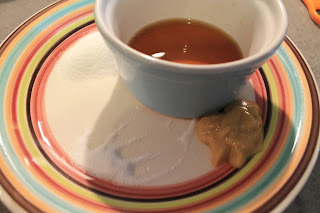Finding myself spoilt for choice, I decided to steer away from Korean dishes, like Bulgogi, that might be more familiar to the European palate - instead I chose a less familiar dish Naengmyun. Perfect for hot summer weather - it translates as 'cold noodles'
The Ingredients
 |
| The ingredients |
1 onion - 양파 (yangpa)
1/4 white radish/mooli - 무 (mu)
1/2 cucumber - 오이 (oi)
1 leek - 리크 (likeu)
1 Asian pear - 배나무 (baenamu) - unfortunately, I couldn't find an Asian pear, so I substituted with a European pear - 서양배 (seoyangbae)
Fresh ginger - 생강 (saeng-gang)
4 cloves of garlic - 마늘 (maneul)
Buckwheat noodles - 소바 (soba)
Shaoxing rice wine - 사오싱주 (saosingju)
Mustard - 머스터드 (meoseuteodeu)
1 egg - 달걀 (dalgyal)
salt - 소금 (sogeum)
sugar - 설탕 (seoltang)
How I made Naengmyun - 냉면
I started by boiling a large pot of water, then added the beef which I had cut into strips. The recipe recommended boiling a whole flank of beef and cutting it into strips later, but I thought this method would be more effective and less messy!
 |
| Bring a pot of water to the boil and add the beef strips |
 |
| Remove the beefy froth that forms on top of the boiling water |
First I prepared the white radish - by cutting off 1/4 of the vegetable - peeling it and chopping it into small bite-size sticks. It was my first time to prepare white radish and I really like the taste and crunchy texture of it. I coated the radish sticks in sugar, salt and rice wine. I then prepared the cucumber and pear in a similar way and put all three in the fridge to be served later.
 |
| White radish, called Mooli in Hindi |
 |
| Chop the white radish into bite-size sticks |
 |
| Prepare the cucumber by de-seeding |
 |
| Also take the core out of the pear |
 |
| Cucumber and pear sticks ready for chilling! |
Next I prepared the noodles - boiling them in water for about two minutes, before draining them until the water ran clear. I also put them in a bowl in the fridge for later.
 |
| Boil the buckwheat noodles (soba) for about two minutes |
After simmering the beef for 45 minutes, I prepared the vegetables that would go with it, to make the broth. This involved washing and chopping the leek, cutting the onion, garlic and ginger root into small pieces. Once the beef had simmered for about an hour, I added the vegetables, brought the whole lot to the boil and then simmered again for another twenty minutes.
 |
| Prepare the leek, onion, ginger and garlic |
 |
| Add the vegetables to the pot and simmer for a further 20 minutes |
My final touch was to prepare a saucer and ramekin with the condiments; salt, sugar, rice wine and ginger - to be added to the soup at the very end. I also hard-boiled an egg and put this in the fridge to chill.
 |
| The condiments: sugar, salt, mustard and Shaoxing rice wine |
When the beef and vegetables had fully cooked, I strained the broth into a container - put the meat and vegetables in another container and put the whole lot in the fridge to chill.
 |
| Beef and vegetable broth |
 |
| Chill the beef and vegetables in the fridge |
Naengmyun is best served cold, on a hot summer's day. It's a bit weird, from a European perspective, to eat cold soup, but I wanted to do it proper Korean-style!
 |
| Naengmyun |
 |
| Close-up with Hite beer |
After chilling all the ingredients, I set the table - then invited my partner to make his dinner by adding the cold broth, noodles, meat and vegetables, radish, cucumber and pear sticks, egg and condiments. Oh - and not forgetting a cold Hite beer!
Buying Korean food in London
Although I couldn't find Asian pear, I managed to find all of the other ingredients for this dish by taking a trip to Burlington Road in New Malden, Kingston-upon-Thames - the heart of London's Korean community.
As well as buying the ingredients for Naengmyun, I also bought some ready-made Kimchi (김치 ) and some Soju (소주), just to taste!
 |
| Kimchi and Soju |
Image credits:
All photos were taken by me, please feel free to reuse, under the Creative Commons license:
Attribution (especially to this blog post)
Share alike
Non-commercial

No comments:
Post a Comment